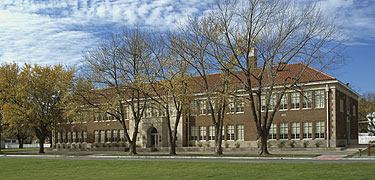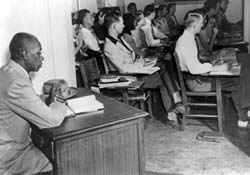
Topeka, Kansas is the state capital and is home to over 100,000 residents. I made it to Topeka, Kansas on my Missouri/Kansas road trip in the spring of 2011. I spent a couple of hours at this National Historic site and the harrowing images from this time have stuck with me ever since.
The Civil Rights struggle is certainly one of the darkest moments in American history. During the early 20th century, the “separate but equal” ruling of Plessy vs. Ferguson had legitimized the move toward racial segregation in many parts of the country. The Plessy vs. Ferguson case involved Homer Plessy boarding a train in the “white” section of a train car, he refused to move to the colored section, subsequently he was arrested and jailed. Mr. Plessy appealed his case to the Supreme Court, where they ruled that “separate but equal” was acceptable. The idea was that separation of citizens of different races and genders was legal as long as the facilities were of equal quality. This case took place in Louisiana, and many often think of this issue as a "Southern" issue, but this racial controversy existed elsewhere including the District of Columbia, Delaware and Kansas.
 |
| The Brown vs. Board of Education National Historic Site in Topeka, Kansas |
In most instances (including public bathrooms, water fountains, cafes and most relevant public schools) the facilities were not of equal quality. In 1952, there were cases from Kansas, Delaware, Washington, D.C., South Carolina and Virginia which challenged segregation in public schools. The U.S. Supreme Court consolidated them into one case named after Oliver Brown in Topeka, KS. One of the most pivotal cases in U.S. History became formally known as Oliver Brown et al vs. The Board of Education of Topeka, KS et al. Because all the cases were consolidated under the one name, the Brown moniker has stuck in history. The case involved Oliver Brown’s daughter who had to walk six blocks and ride a bus over a mile to get to a segregated school while the white school was approximately seven blocks from her house. Oliver Brown decided to attempt to enroll his child in the white school, she was denied admission and directed towards the segregated school. Initially, the District Court found for the Board of Education based on the Plessy vs. Ferguson precedent, and the case was appealed all the way to the United States Supreme Court. Thurgood Marshall (later appointed to the U.S. Supreme Court) would take the case as the chief counsel for the National Association for the Advancement of Colored People (NAACP).
The strategy of the NAACP was to point out things that were shortcomings of "Separate But Equal". In some cases the inequality was overt. African-American children were made to go to separate schools on a bus even if one were blocks away, the African-American schools may not have the same coursework or programs as the white schools. In other instances inequalities were subtle, renovations were delayed, cost/student disparities were present. Some instances of the "Separate But Equal" were just humiliating, like George McLaurin. Mr. McLaurin fought to get admitted into the University of Oklahoma because they offered coursework in public education administration which wasn't available at the segregated school, only to be humiliated by being made to sit in the corner of the room.
 |
| George W. McLaurin (!887-1968) was forced to sit in a separate classroom, library, cafeteria, and restroom areas while attending the University of Oklahoma. |
The Brown vs the Board of Education museum itself is a renovated schoolhouse that was in use at the time. There are pictures of classrooms and school children throughout the museum that reflect the era. The main atrium at the center of the room has a series of educational films that walk young students through the Civil Rights movement through the eyes of a modern day teenager. There is another gallery where one can learn more about the people, places and events that shaped the years right before and after the decision. In this room is a passageway that may not be appropriate for young children as the language and some of the imagery is deplorable, but it gives one a sense of what vitriol existed at the time. This exhibit really stuck with me. There are other exhibits throughout the site that outline the legacy of Brown vs. Board of Education where the case is linked to the larger Civil Rights movement, and other struggles for equality like South African apartheid and the Polish Trade Union, Solidarity lead by Lech Wałęsa in the 1980's.
Here is a brief clip from PBS about the case with some background.

No comments:
Post a Comment